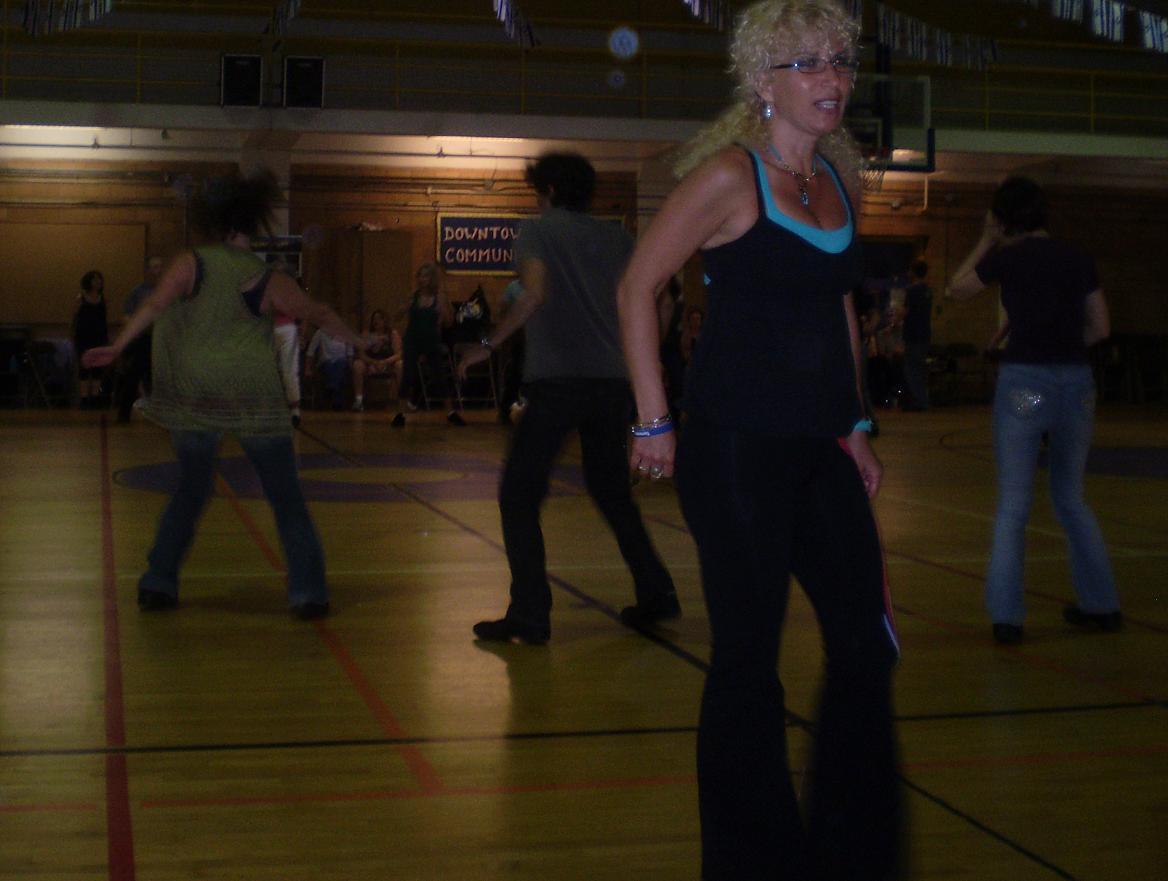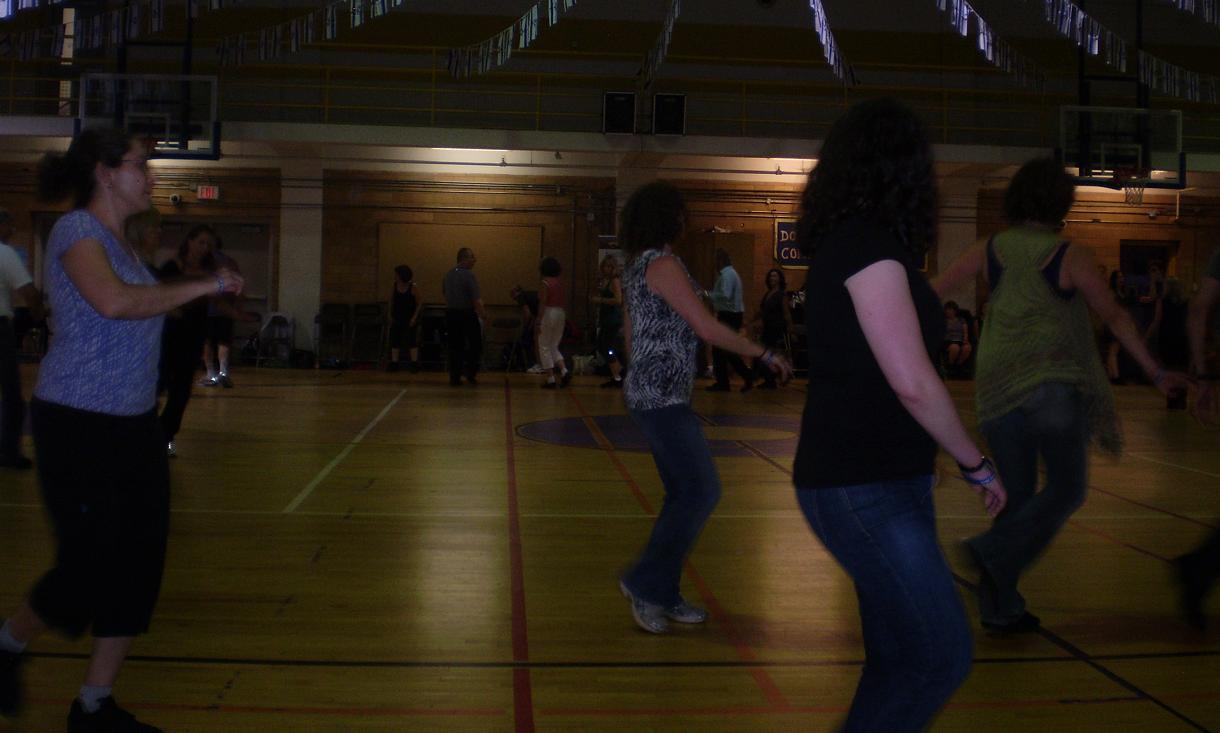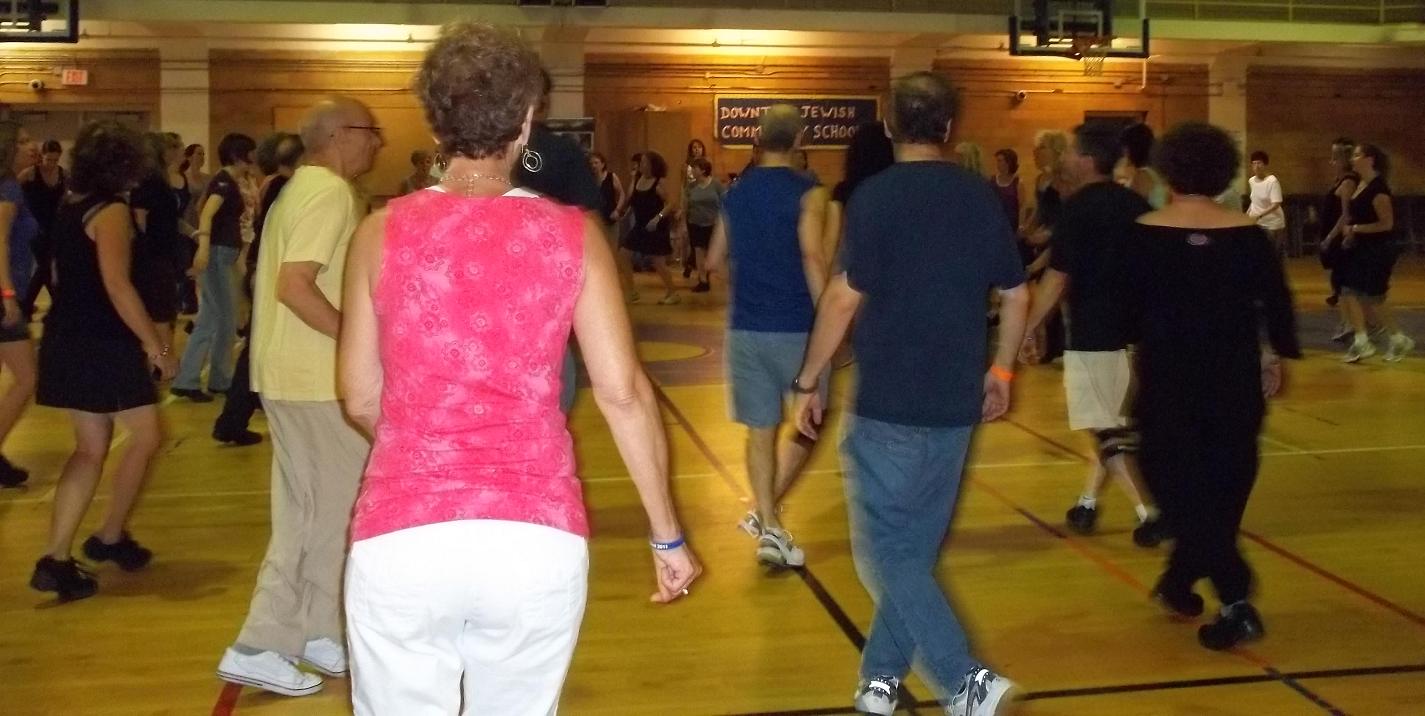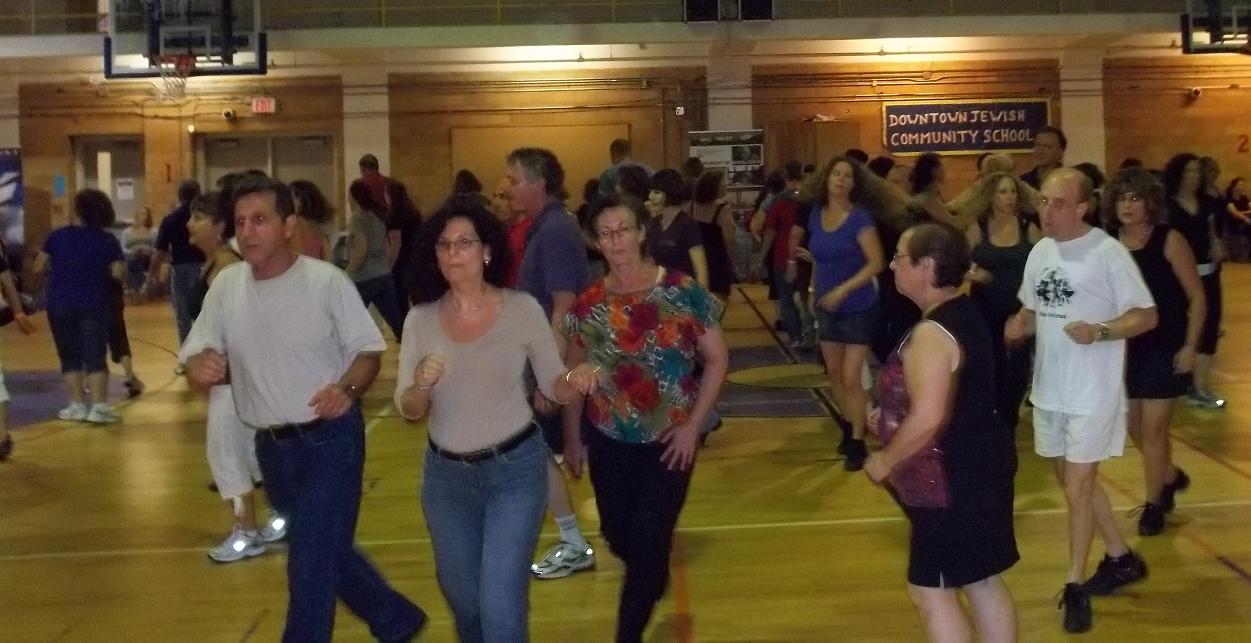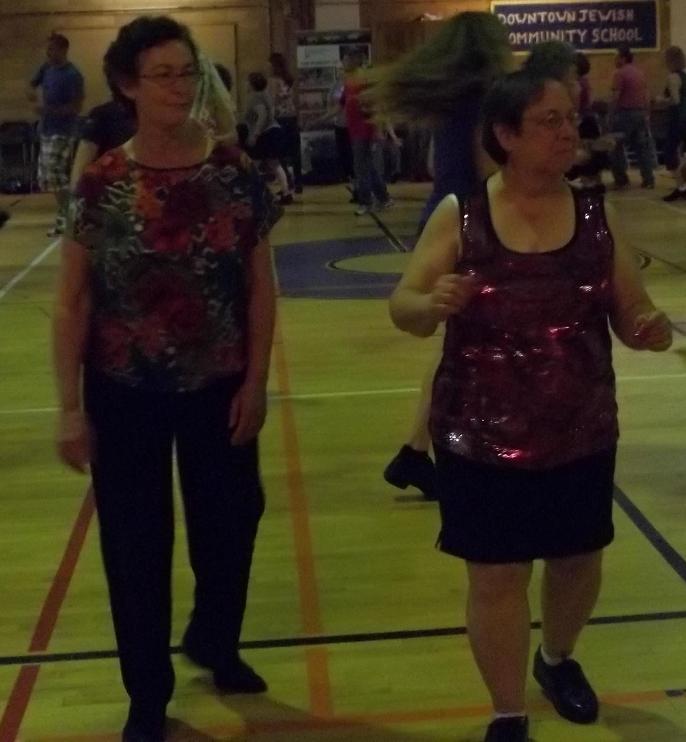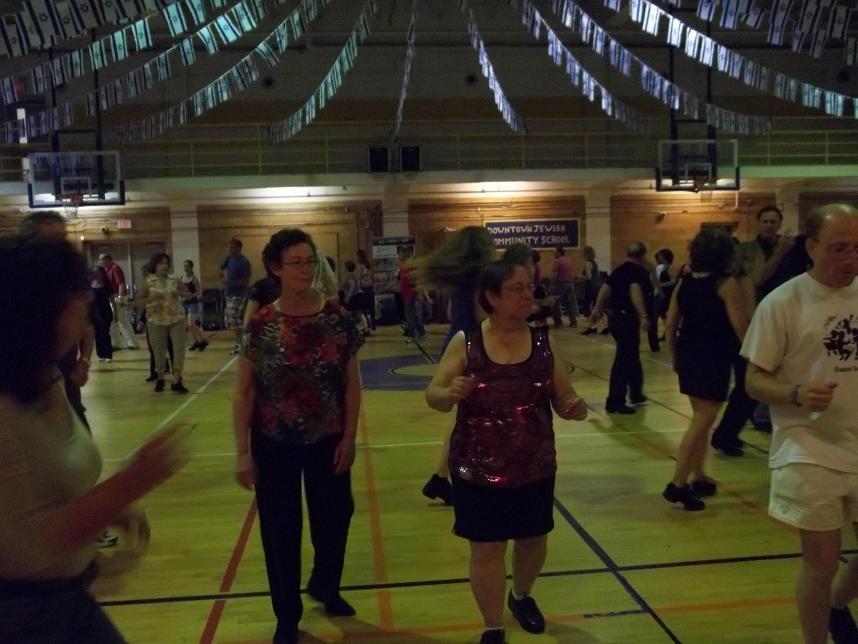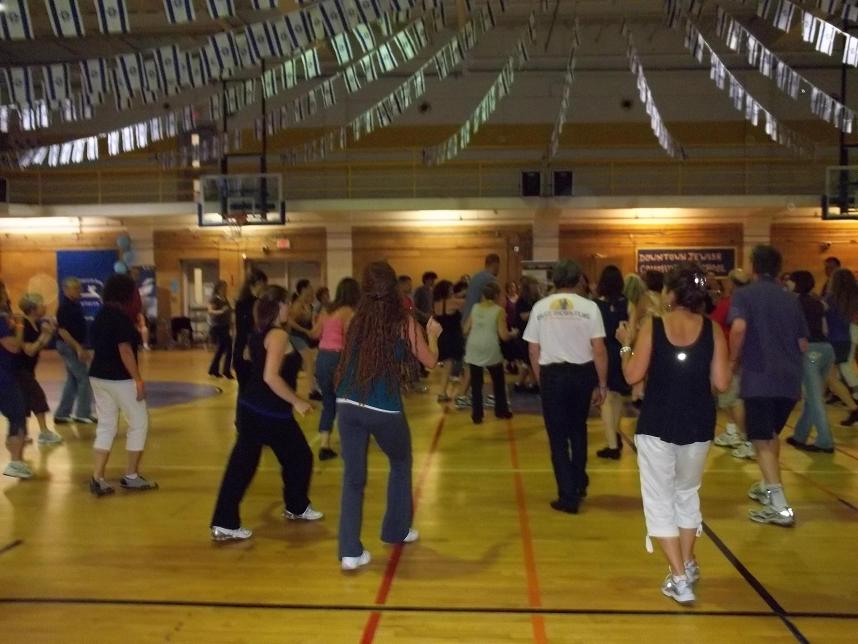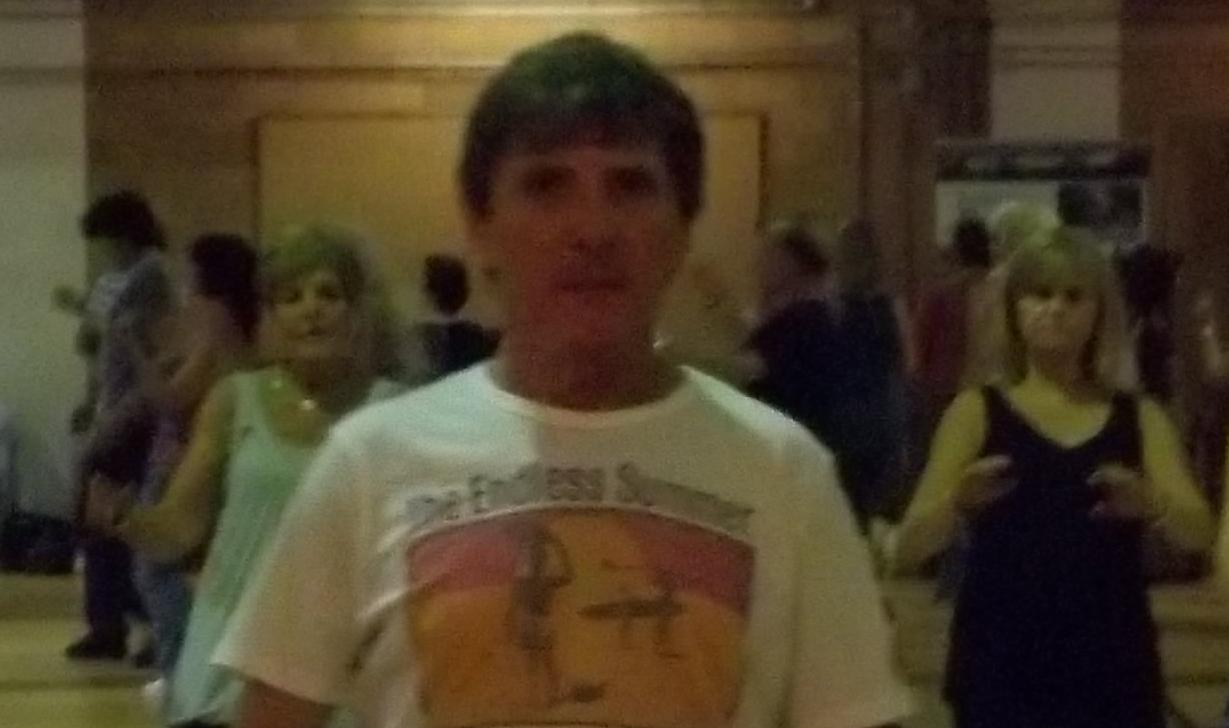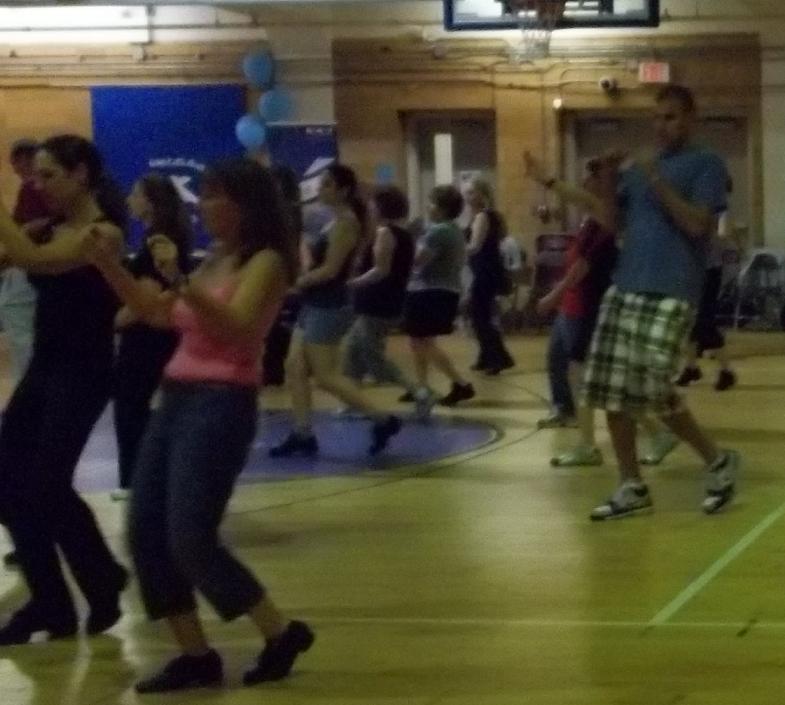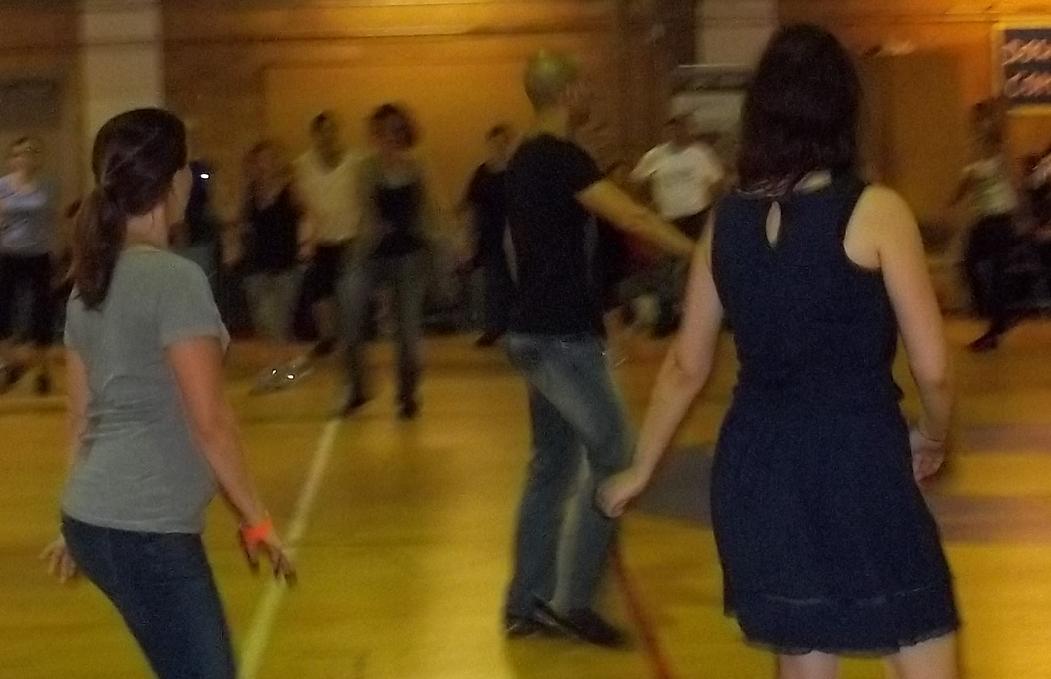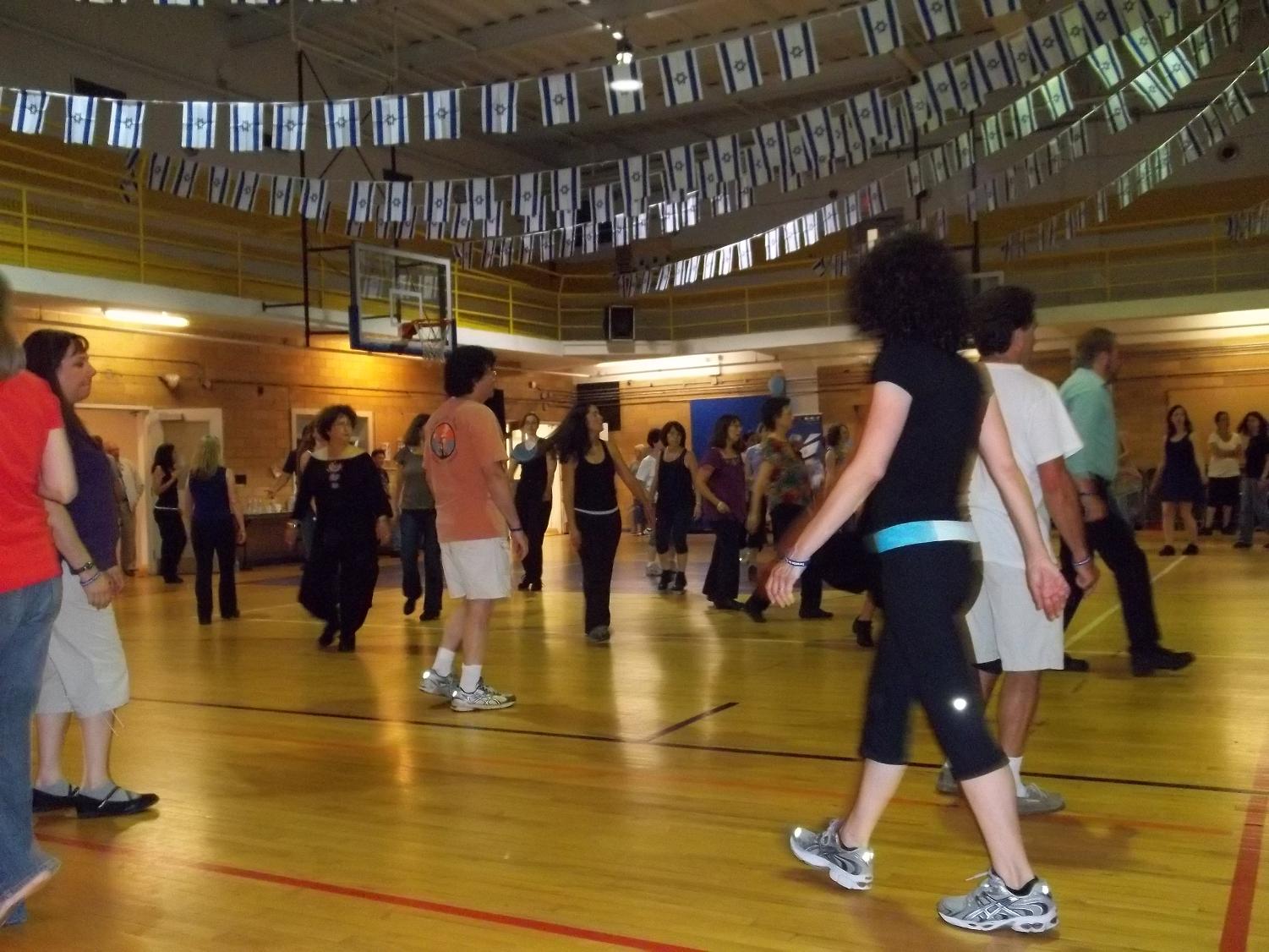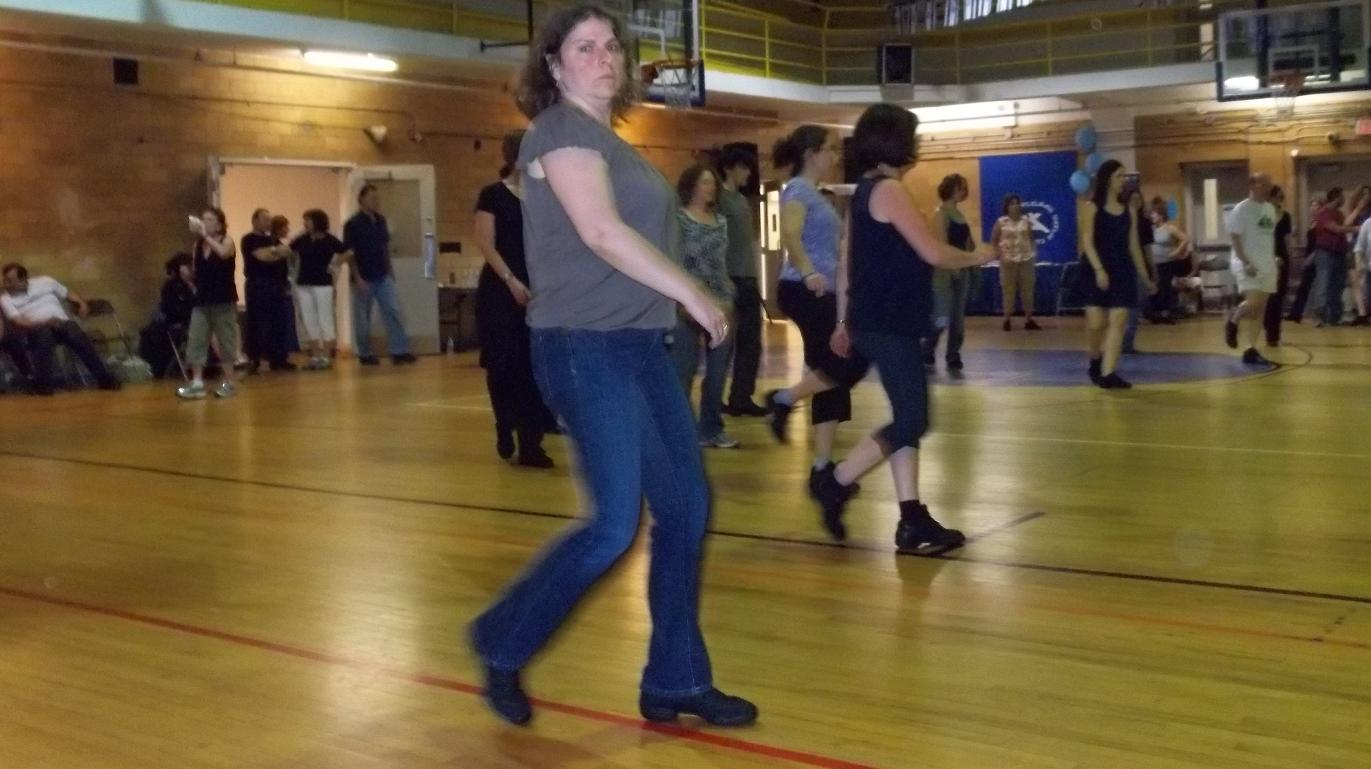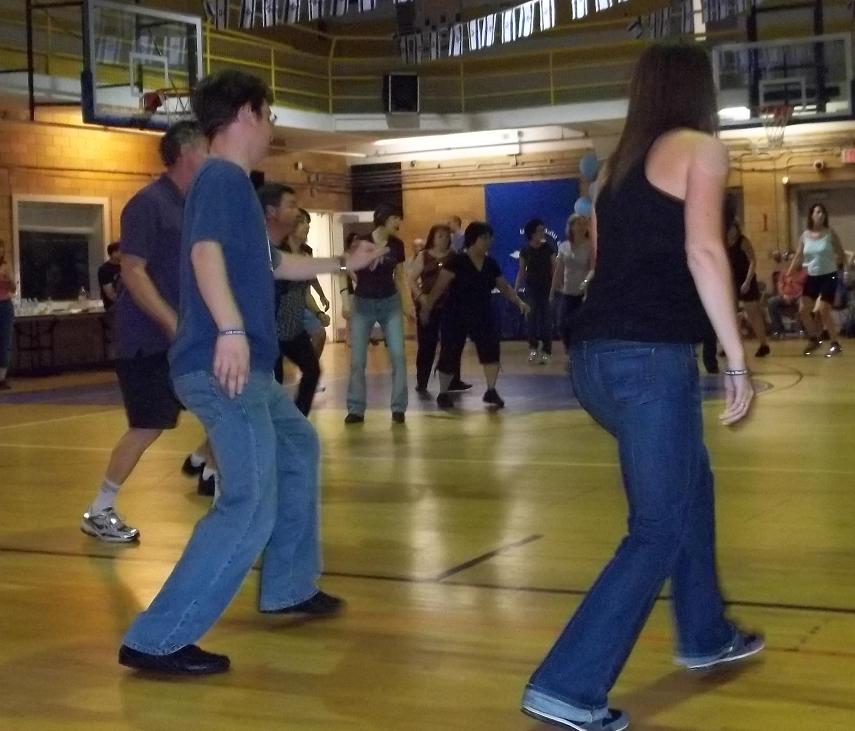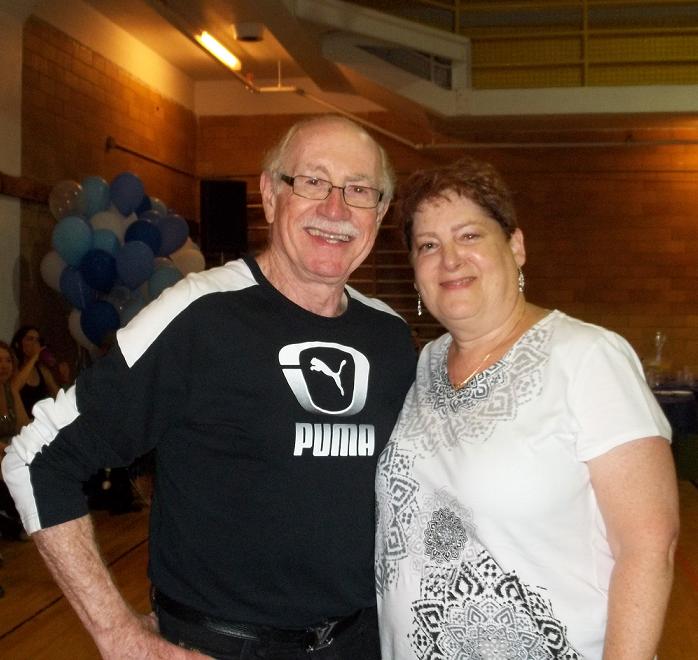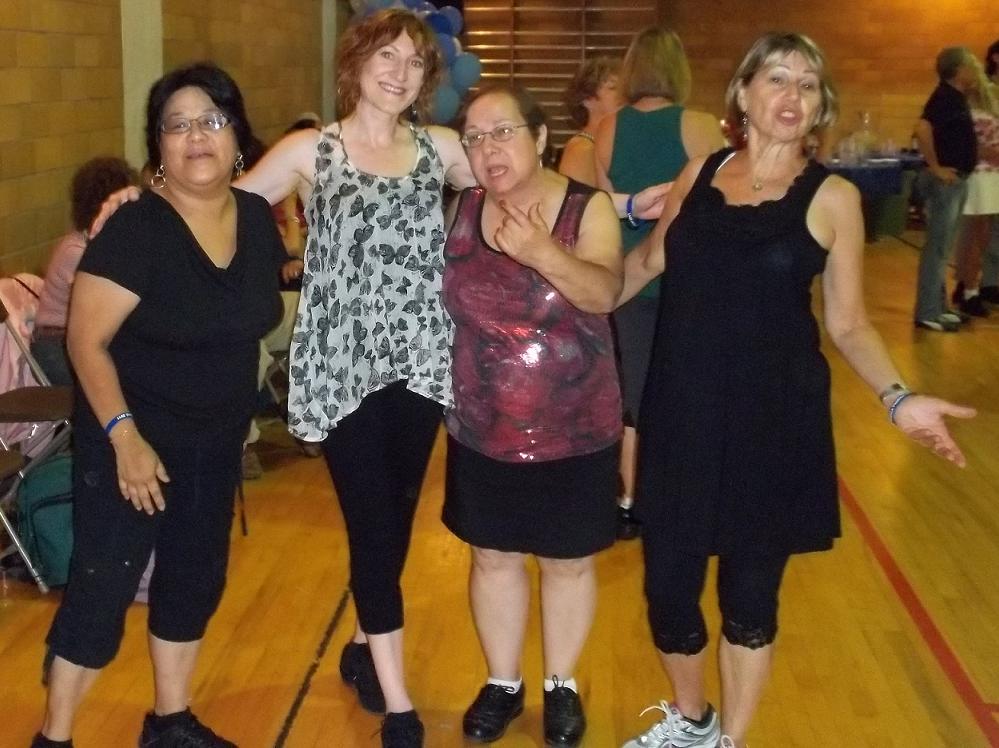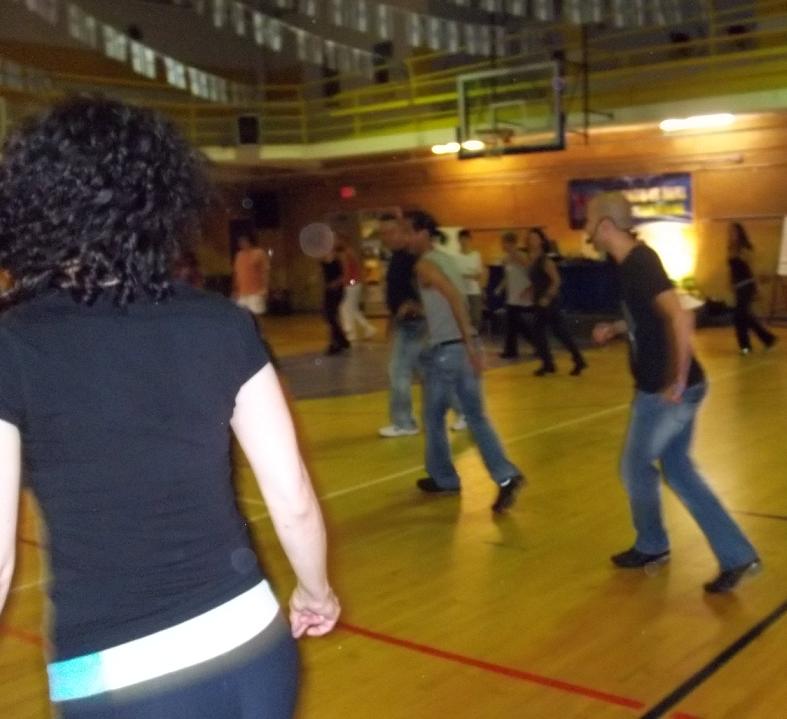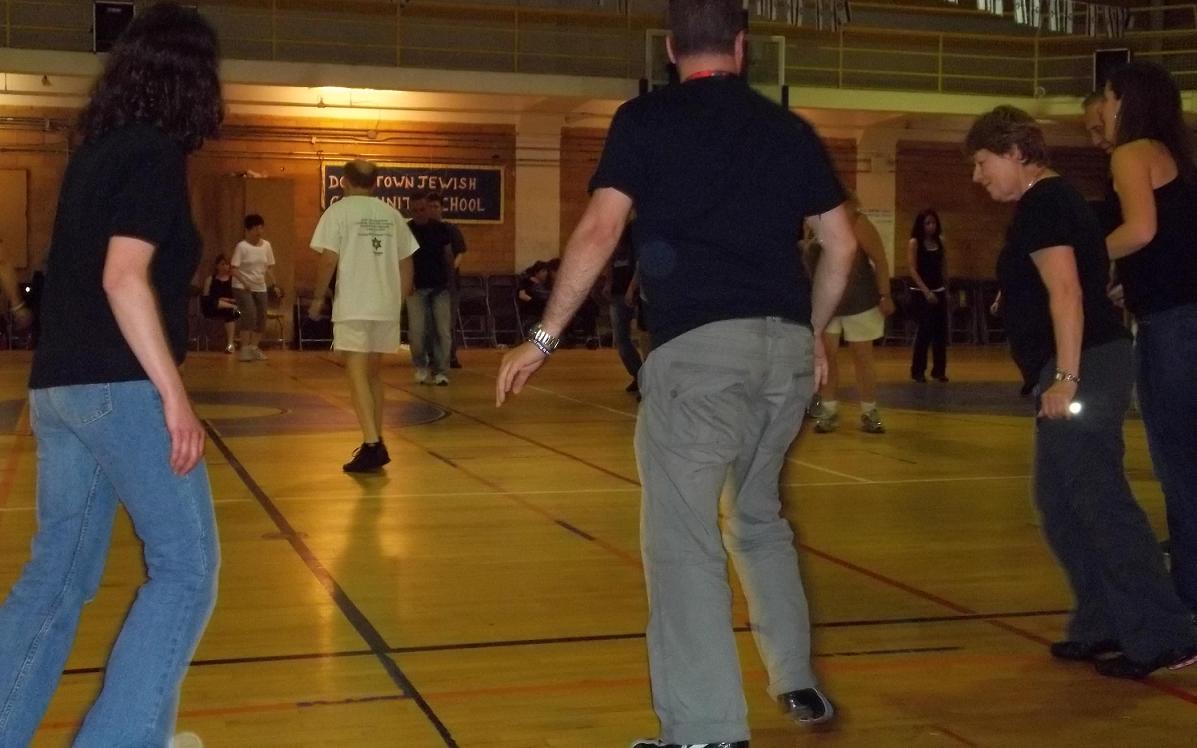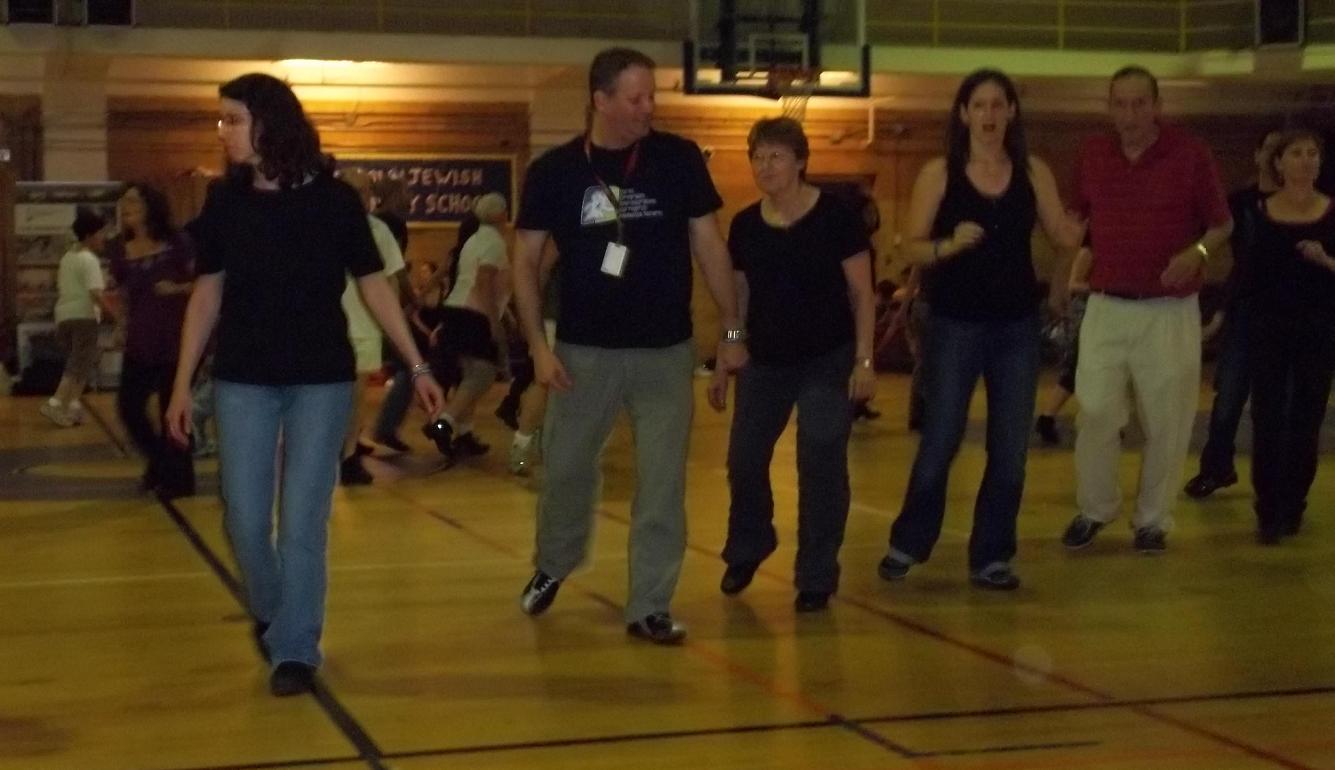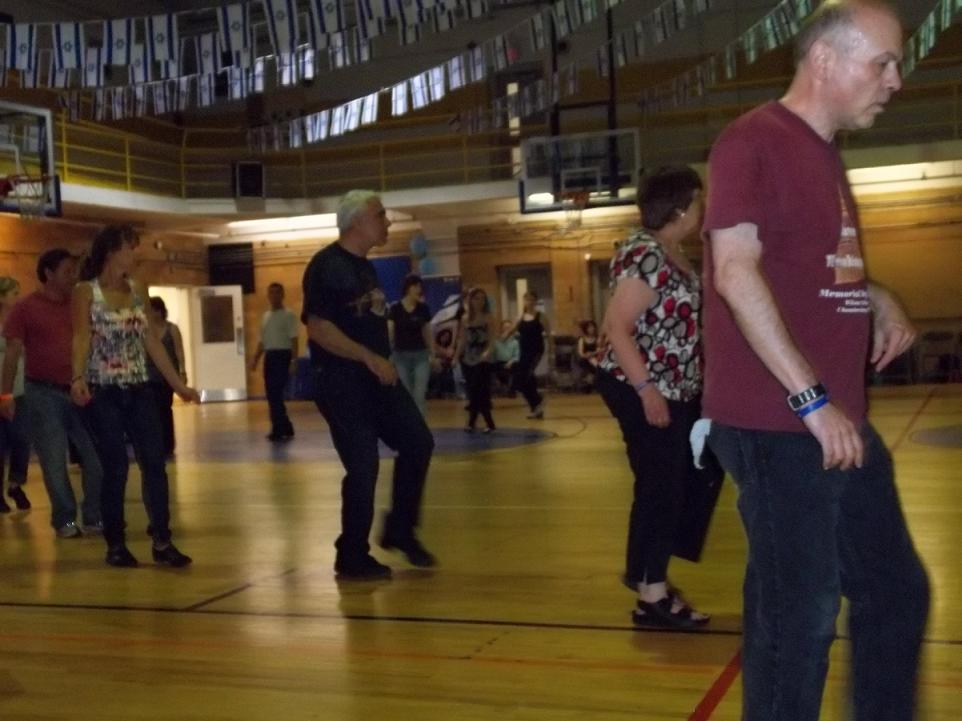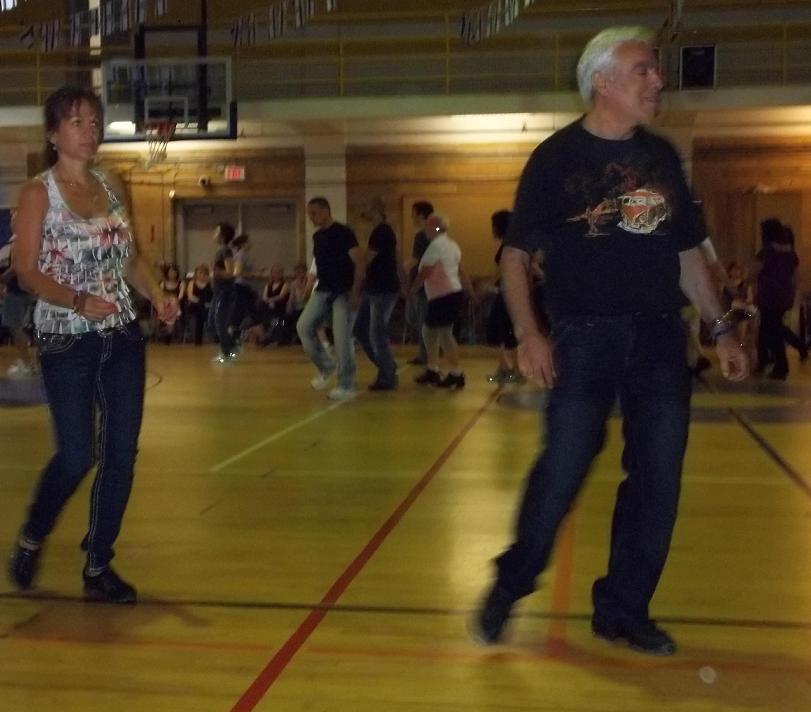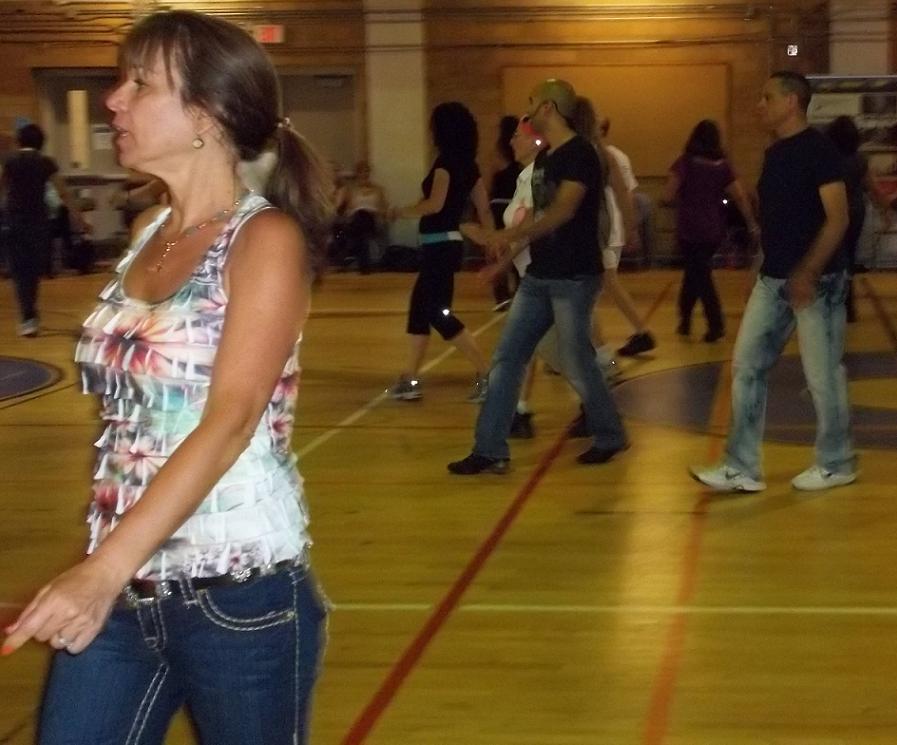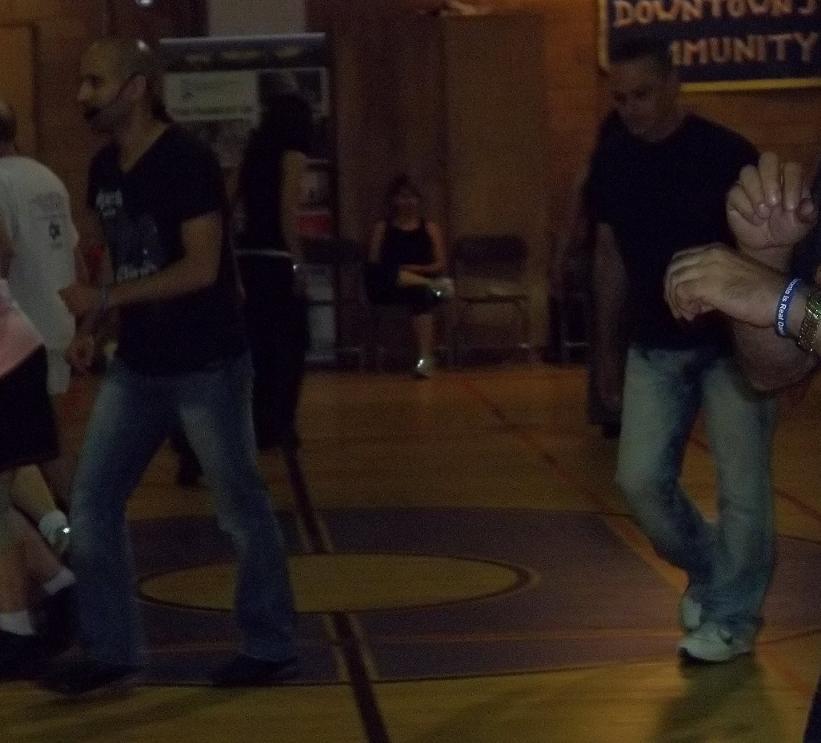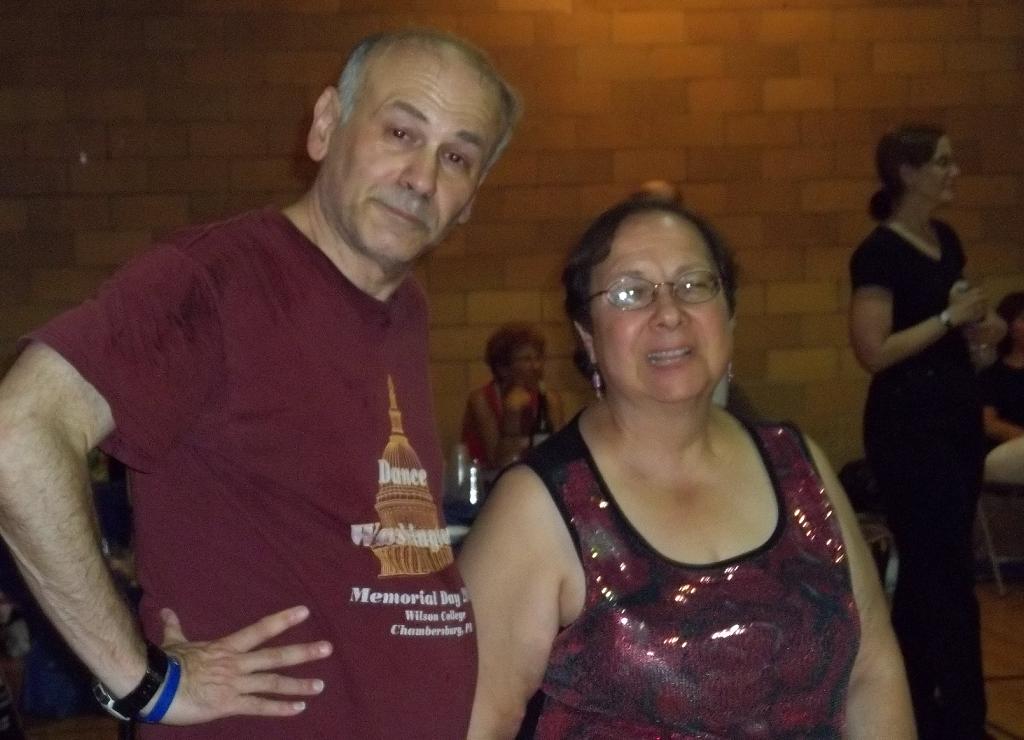This web site has been created to cover mainly Israeli dancing (and some folk dancing) within the Greater Philadelphia area. However, we do feel that we should cover some of the activities of our Philadelphia dancers as they travel beyond the boundaries of our coverage area. Recently, a group did so and we asked two of the members, Sharon Polsky and Andrea Wallach to use their cameras to pictorially denote and document the trip. Below are the particulars:
On the weekend between July 1st, 2011, Canada Day thoughout Canada and July 4th, Independence day in our country, the sixth annual Toronto Is Real Israeli dance workshop was held at the Miles Nadal Centre in the heart of Toronto, at the intersection of Spadina and Bloor within (if not on) the boundaries of what would be the University Of Toronto campus.
For the 2011 festival, five intrepid Philadelphia based dancers navigated the 330 miles (530 kilometers for those of you who are into the metric system) distance to Toronto by several means to participate in the workshop. Sharon Polsky and Lee Friedman took one car. Becky Perez took another car. Andrea Wallach and Marc Rauer took Air Wisconsin flying under the banner of US Air.
About Toronto
Toronto bases its history to the establishment of the Town Of York in 1793 in what at the time would have been considered as Upper Canada. The major peril for this Town of York was a US invasion and its primary purpose in its earliest era was as a fort to oversee the western reaches of Lake Ontorio. This would become important during the War Of 1812 (The British side would call this the North American portion of the Napoleonic Wars) when Canada was invaded twice, both unsuccessively, near Detroit and at the Niagara Peninsula. It also was used to reinforce British claims to the Hudson Bay (through the Hudson Bay company) and a link, Yonge Street in Today's Toronto, connected both of these locations. Today, you can shop and sightsee on Yonge street and probably not be aware that it has claim of being the longest continuous street in the world. If you want more information on this history of Toronto, the Town Of York Historical Society maintains a web site at www.townofyork.com.
By 1834, this fort had grown into a small town and its name was changed to the City Of Toronto. Even the need to protect Canadian/British interests in the western part of Lake Onterio would subside some 8 years later as the United States and Britain, representing the British colony of Canada, signed an agreement defining the boundaries of the two countries up to the Lake Of The Woods (between Minnesota and Manitoba). Subsequently the entire boundary between the two countries would be settled in the late 1800's.
The animosity of the two neighboring countries, so evident prior to the US Civil War, has passed into a great friendship and it is claimed that the US - Canada border is the longest demilitarized border between 2 countries in the world. For many years, a state driver's license was enough to pass back and forth but since June 2009 a requirement of a valid passport has been in effect.
Without a rivalry between the countries, the next rivalry that would engulf Toronto would be in hockey where the Toronto Maple Leafs would compete against two teams in the fledging NHL (National Hockey League), the Montral Maroons and the famous Montreal Canadiens. The Maroons folded before World War II but the rivalry between the Leafs and Canadiens continues to this day. We should add that the Maroons got their name by the color of their uniforms and are not the only team ever to bear this nickname: Those familiar with the precursor of the present NFL, will remember the Pottsville Maroons of Pottsville, Pa who some suggest were the real winners of the 1925 season.
Toronto is a mixture of a European and North American city. For the US traveler the concept of open air eating and a transit system based on light rail (trolleys) on their own rights of way in the middle of wide boulevards is very appealing. But, your appliances work just as they do in the United States and, while there are differences in some vowel pronunciation, everything is conducted in English.


Getting To Toronto
For our group of intrepid Philadelphia based dancers, getting from Phila to Toronto can be done by Car or Plane. If you push it, it can be as low as 8 hours of driving generally going through the New York highway system which as you go north becomes quite picturesque. By plane, it is a little over an hour but being an international flight, one is expected at the airport 3 hours before take off and, as one of our interepid travellers would find out, there is always a possibility of a delay going through Canadian customs and immigration. To the right is a map showing the direct flight route in red and the drive routes in blue.
If doing this trip by car, assume about $150 in expenses based on gas and tolls. In the 8 hours one would expect to have to stop for a meal somewhere. If going by plane, it is said that 7 airlines operate back and forth between Phila International airport and Toronto's Lester Pearson airport. The fare structure is as low as $260 round trip if flying United and, on all of these, because of the limited distance, you are flying a plane whose corporate ownership is under license to a more well known carrier. You could double your cost by flying US Air.
For whatever reason, the group of travelers in our saga who flew, did choose Us Air and found that they really flying Air Wisconsin licensed to the US Air system. This carrier's fleet consists of Bombardier CRJ 200's (shown to the right) with a seating capacity of about 50. And, so, it was a CRJ 200, operated by Air Wisconsin, that our two intrepid plane travellers from Philadelphia used for their flight.
While the name Air Wisconsin would seem to conjure up an airline serving that state, in reality this is an airline that services much of the Northeast and the Middle Atlantic states generally flying under the US Air banner. A subsidiary of Air Wisconsin also provides maintenance services to United at its hub in DC. This would come in handy given the failure of some component on the CRJ200 that was scheduled to be used by our traveler's for the flight to Toronto from Phila Intl airport. Apparently something had failed on the flight in and had to be replaced by the carrier's maintenance staff delaying the departure.
Besides this advantage as per maintenance, there may be other reasons to book Air Wisconsin. Suppose one has a need at a future time, just to give some theoretical examples, to attend a Packers game in Green Bay or some tryst in Madison, Air Wisconsin may be your carrier of choice because no doubt this would earn you frequent flying miles on the US air system.
In your calculation of cost of air flight, don't forget to count the cab fare to and from the Pearson airport to your hotel when you arrive and depart fron Toronto. Many of the hotels quote this as a 30 to 35 Canadian dollar cab ride each way but double this estimate when dealing with the real life scenario.
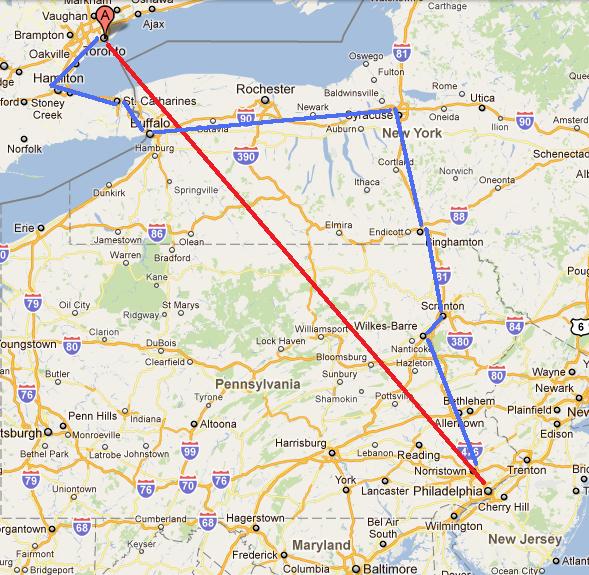
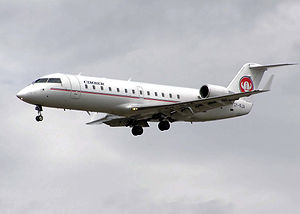
Facts about Canada and its monetary system
Given that we have already told you that you need a passport to enter, it should be no shocker that Canada is not a part of the United States and is an independent country. Therefore, it also has its own currency. To the right, at bottom, we have indicated the look of the Canadian currency which generally features images of the reigning British Monarch on one side. As the ruler of England is the nominal head of state for Canada, you should be able to understand this connection
At one time your US dollar could be used quite easily within this country but those days are probably gone forever. In areas close the border on either side, you can interchange US and Canadian currency at commercial establishments but in today's world you cannot readily find this option in Toronto.
Exchange rates are governed by markets and in July 2011 the exchange rate, which fluctuates daily, was about 1.05 dollars for each Canadian dollar. A picture to the right illustrates the fluctuations of the Canadian vs US dollar over the first half of 2011.
Speaking of the different dollars, the banking system is very different and the banks that you see on the retail level on streets will not ring a bell as to familiarity. So, if you need money, you are in need of ATM machines which will give you Canadian dollars, calculate the conversion of the Canadian currency into US Dollars, add a surcharge and charge your account in this country. And, yes, in foreign exchange, always expect a surcharge unless you are dealing with foreign exchange as a broker swaping millions or billions in an exchange market. Please note, however, that we would discourage your spending the next 5 years studying to be a foreign exchange broker in order to gain a fleeting monetary advantage while attending an occasional Israeli dance festival outside of the US.
However, It would be a good idea to call your local banker and inform them that you are travelling to Canada so they will accept charges without thinking your card has been stolen. This does not guarantee that your card will be accepted everywhere in Toronto as some of our intrepid travellers were to find out.
We can give you a specific no-no, in case you are interested. It is not good practice to have your local bank branch authorize a replacement debit card from your bank days before embarking on your trip to Canada. Once a replacement card is mailed to your home, the original card is cancelled and since you are not at home, you no longer have use of your funds through the now cancelled debit card in your possession. And, you just can't walk into a Canadian bank and resolve this. As mentioned before, you cannot find branches of your bank at home up north in this country.
However, if this does happen to you (and we can report that one of our intrepid traveller's did find themselves in this position), make sure that you have gone with a group of people you can borrow money from, like a group Israeli dancers you might know, and keep good records as this web site believes all would like to be reinbursed when everyone eventually returns home.


Arrival in Toronto
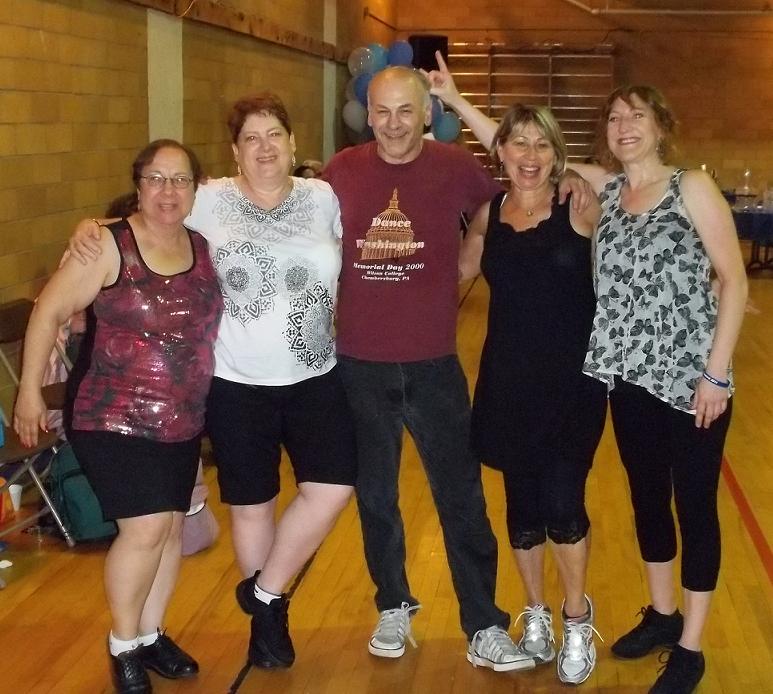
Above, we have a picture of the dancers who will be highlighted in the script that follows. This picture was taken late Saturday night while the festival was underway. From left to right is Lee Friedman, Sharon Polsky, Marc Rauer, Becky Peretz and Andrea Wallach. Several New Yorkers (as well as some of the Washington dancers) were at the festival, including Jane Tardell, and they become honorary Delaware Valley dancers in terms of dinner arrangements and dancing partner arrangements. You most certainly were not aware of this, as it was kept very hush-hush, and this web site is the first to break this after extensive investigation covering two countries and multiple dance sessions, but it is possible that the Canadian authorities took one of our intrepid travellers as a possible terrorist as events would seem to indicate although his release was secured after about an hour of questioning and searching.
As indicated above, the members of this group made their way to the festival by auto or plane and each of the group had some interesting stories to tell. One car decided to visit Niagara Falls on the way to Toronto and reported how breathtaking and awesome the falls were. Another car went up to New York City and was able to visit around that city before heading north to Canada.
But apparently the most fun had was that of our intrepid flyers. Upon landing, they agreed to swap carry-ons just to confuse the authorities, we have been told, and when one of our travellers was questioned by immigration authorities, this switch only fueled these officials' suspicions. Apparently the Pooh bear that fell out of the interchanged carry-on when searched did not help in these matters. An uncomfortable hour would elapse while in custody.
Luckily, we can report that after dropping to his knees and promising to leave the country as soon as the dance festival was over, our traveller received a stern warning about switching bags, especially with strange women, in an airport and then was free to go. We were not told who this strange woman might be that was alluded to by the authorities but, perhaps, you may get some clue if you carefully study the picture above. Anyway, by hook and especially by crook, the parties become situated in Toronto as they readied for the dance festival and, for some, some activities beforehand.
Lodging in Toronto
The Philadelphia group was split between staying at the Madison Manor Boutique Hotel (second picture on right) and the Holiday Inn. Both were within blocks of the Miles Nadal center and are in the University Of Toronto area as indicated in the map to the right. The Holiday Inn is on Bloor street, and like many of the hotels in Toronto, was in the midst of a labor problem as the local union that represents hotel workers was systematically employing picket lines at various hotels in the city during contract negotiations. Thursday, June 30th was the Holiday Inn's turn and this picket line was what awaited those booking into that hotel if they arrived that day.
A block east of this, where Madison street intersects Bloor, lies the Madison Manor Boutique hotel which is rather unique. This complex consists of 3 adjacent buildings two of which are connected. Many years ago, because this is within the University of Toronto area and situated next to a fraternity house, an interconnecting set of pubs and bars were built into the connecting structures. We have been told that the pubs are activated as the number of pub goers (both eaters and drinkers) increases and since June 30th was the day before the Canadian National Holiday, Canada Day, all the pubs would be in operation through that evening and into the night with party goers. The 3rd building between the pubs and the Frat house is the hotel with 22 uniquely patterned rooms. Apparently, it is the luck of the draw as to how the noise will affect you. Some of our intrepid explorers reported no noise at all and slept peacefully through the night. One, however, reported that it was like being within a frat party for the entire weekend including that evening as his room faced the pubs in the other buildings. Very limited and often interrupted sleep was the order of that night and for the entire weekend.
Both hotels offered food services through facilities within each complex. The Holiday Inn had a restaurant accessible from the street or the hotel and you are already aware of the food services of the various pubs and eateries within the Madison House and most of our intrepid travelers used both facilities for breakfasts and occasional dinners.

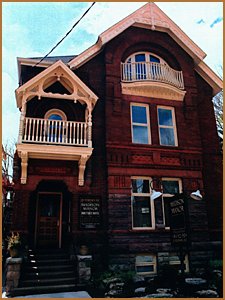
Take Me Out To The Ball Game

Welcome to the morning of July 1st and the picture above, the ticket to the July 1st, 2011, Phillies BlueJays game, portends the big event of this day as related to this web site. Many have slept and quite well, one has not. On this night, the Toronto Is Real Israeli dance festival is to begin. But, except for one of our travellers, they are about to experience something that only the fates could provide. One of the group mused several months before as preparations for the trip were in their infancy whether the Phillies would be in Toronto this weekend? Yes, indeed, they were, and were opening a three game series with Toronto at 1:07 PM in the afternoon. It would be physically possible to attend the game and attend the dance festival later that evening. One of the participants took it upon himself to secure tickets for four of our travellers, Sharon Polsky, Lee Friedman, Andrea Wallach and Mark Rauer and about 12:15PM that afternoon, from the cab stand in front of the Holiday Inn, this group set out for the Rogers Centre where the Toronto Blue Jays play their home games.
These tickets were bought independent of the Phillies who this season are running excursions of Phillies' fans to several cities including Toronto. But, going through the Phillies requires participants to attend all three games of the series and our group would be dancing on the other days of this weekend. So. these tickets were purchased through the Toronto Blue Jays ticket office which apparently was unaware as to which dugout the visitors would be using. So, our intrepid travelers ended up above the Toronto dugout amid Toronto fans. We should note that all concerned were very impressed with the Toronto fans who showed exceptional hospitality to the many Phillies fans in attendance including our group. As to those travelling through the Phillies organization: our group reports that a sea of bright red was seated and very noticeable above the Phillies dugout on the first base side of the field.
This web site's personality section, which you can access by clicking here, has a write up that gives the particular details of our group's attendance of the game. For this script, we can report that everyone enjoyed themselves and the Toronto fans were very welcoming even though they would be at the short end of the 7-6 Phillies victory that day.
Everything You Didn't Want To Know About Trolley Cars
Returning from the Rogers Centre to both Hotels afforded everyone the opportunity to use the Toronto transit facilities. The Rogers Centre is at Spadina and the waterfront. Our group needed to get to Spadina and Bloor. There is a trolley line, the 510, that runs those extremes and so it was onto the "rocket", as these Canadian light rail vehicles are nicknamed, to return uptown. For the group, it was a relatively convenient, inexpensive use of the Toronto transit system. No one of the party gave thought to the uniqueness of this trolley car/light rail system when discussing it with this web site. But, as many of you know, this is more than just a relatively mediocre Israeli dance website. We extend our supposed expertise to Ian Fleming and James Bond and to trolleys. So, as trolley car afficiandos, this web site is aware that Toronto is presently the trolley car capital of North America and we have taken the liberty of doing some research to add to the group's perception (and perhaps your's) of their ride.
For Toronto and North America, it wasn't always so. Early in the last century it was Philadelphia through the PRT (Philadelphia rapid transit) and the PSTS (now known as Red Arrow) that had this title and you can read a little more about this by clicking here which describes an excursion to the Trolley Car Diner, in Chestnut Hill, and a short history about transit in Philadelphia. In those years, between 1900 and 1955, Philadelphia was a city of trolley and train and the companies that ran the transit in the city were the most powerful such companies in the world. It was not uncommon to see two tracks of one line cross the two tracks of another line with resultant ability for the trolley car approaching the intersection to go straight, left or right from any direction. You could call this a 4 way trolley crossing. Today, in the Philadelphia system, the maximum coverage is a three way connection done at several points in Southwest Philadlephia.
Most people, including our group, don't realize that this type of trolley crossing requires a lot of technology. Trolley rail is really the urban equivalent of railroads. Trains move and are shunted between tracks through the use of "points" that are thrown (operated) in blockhouses for the most point. This is a closed system as railroads run on their own rights of way. A trolley car line is within a city street. The public would look askance if pedestrians or automobiles were squashed or electrocuted due to this track movement.
What a trolley has going for it is its connection to the overhead wire. This can be used to send a signal to the points to switch and since it is the trolley car operator who is controlling this, he can make sure that there are no accidents as this happens. However, controlling the trolley wire when multiple lines cross tracks in itself is a major problem. To resolve this, the technology of catanary comes into play. Catanaries are overhead wire constructs and this technology is in play in Toronto for its trolley cars and the catanary controls the signals from the trolleys to the tracks.
Unless our group was really taking notice, they would have missed the fact that the Spadina 510 line crosses 4 other trolley lines so there were plenty of the 4 way trolley crossings for their car to navigate. Even one such crossing cannot be found anywhere else in North America as far as research seems to indicate. In addition, these are unique trolleys having been built in the 1990's as the newest in light rail technology for that time period through the auspices and funding of the Province of Ontario.
Finally, the use of specific rights of way on city streets showed what Septa was trying to do with its remake of the Girard Avenue line although this project on Girard Avenue has not been fully successful.
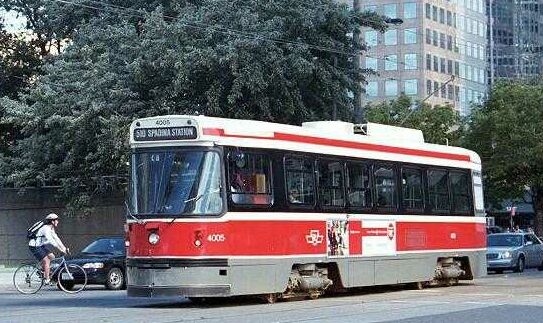
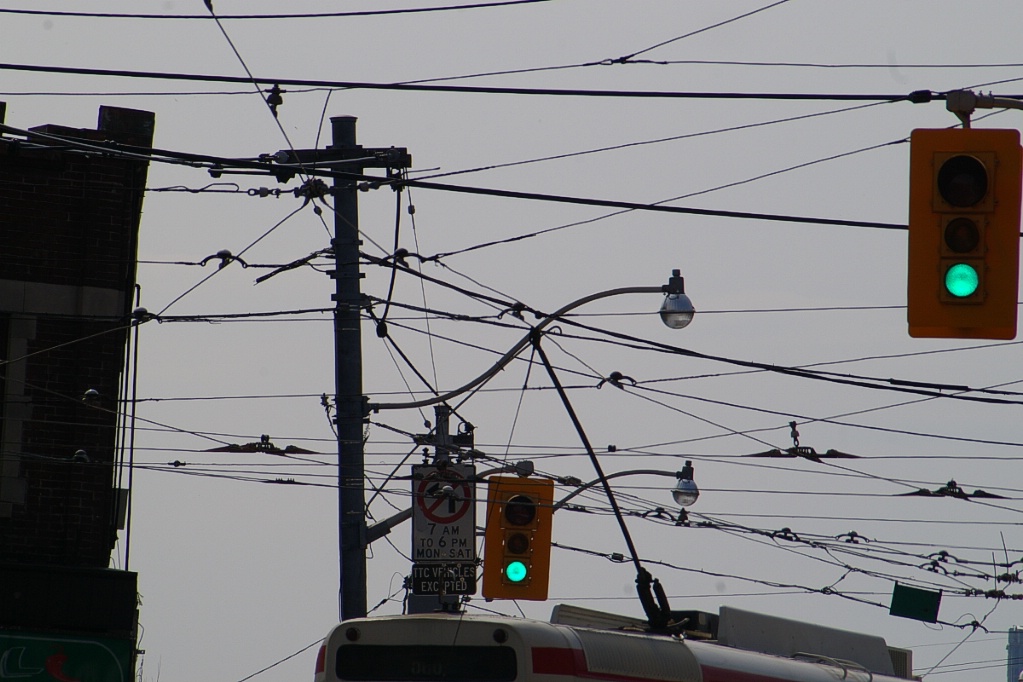
Other Means Of Travel In Toronto
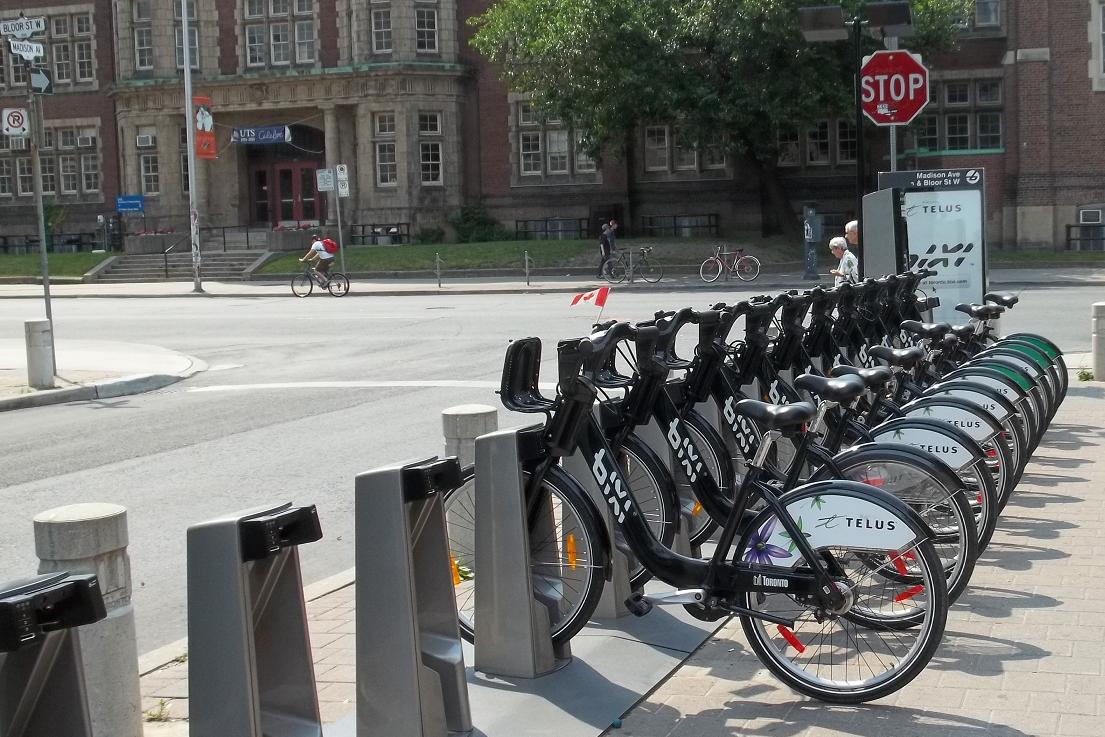
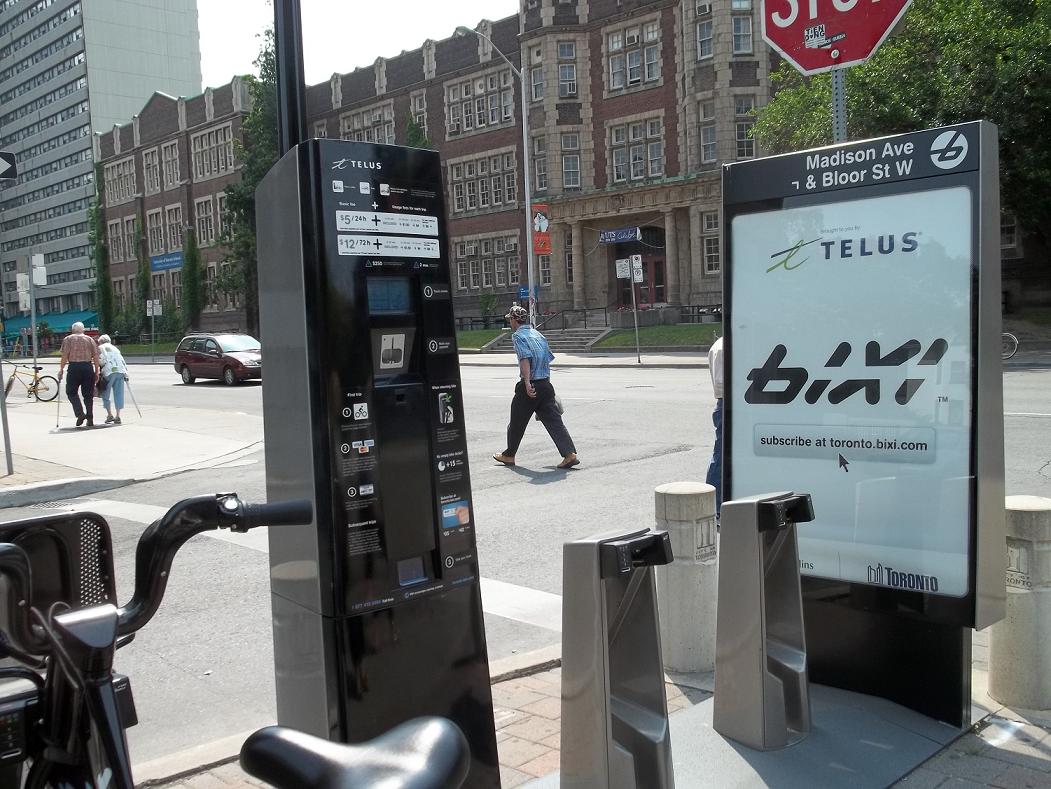
Trolleys and light rail are not the only way to travel around Toronto. The city has a subway system and has incorporated the subway system, the trolley lines and an extensive bus network into a metropolitan transit operation. Like European cities, there is an emphasis on public transit that is lacking in much of the US. In the case of rights of way, differences in eminent domain between the US and Canada (which this web site is assuming) no doubt allow for faster progress of public projects.
But one of our party of Philadelphia based dancers, Sharon Polsky, was very impressed with another aspect of transit that she observed at Bloor and Madison, pictured above, the kiosk where bike sharing is in place. This is similar to car sharing that many cities and areas now use. You can purchase a share of a bike, and you see them in place in one of the pictures above, use the bike and then return it to the original kiosk or perhaps at another kiosk within the city.
Sharon believes plans are in the works for a similar functionality in the Philadelphia region and, with the number of institutions of higher learning, Phila might be a perfect place for this so keep an eye out for this in the future.
Even More Info Our Group Wasn't Interested In
July first was Canada day within that country. So, it was Canada and its formation that monopolized the conversation of one of our group at the end of the trolley ride. Since he has done this at other times, as we have recorded on this web site, questions arise whether he really knows this info or just crams this knowledge into his mind at the right moment. As he won't talk with this web site, we can't answer that question but having queried the others, we can relate the information presented during his brief filibuster. We have accompanied this with several maps at the right that can be found at the Canadahistory web site and others.
- Formerly this holiday was designated as Dominion day celebrating the July 1st, 1867 British North America Act which started the creation of the country of Canada as we know it and the British Commonwealth Of Nations.
- Canada is made up of 10 provinces. Starting west to east is British Columbia, Alberta, Saskatchewan, Manitoba, Ontario, Quebec, New Brunswick, Nova Scotia and Newfoundland. And last but not least is Prince Edward Island known as PEI.
- That our group of intrepid travelers were not only visitors to Canada that weekend. William and Kate were in Ottawa on Friday, July 1st for Canada day at the same time as our group was at Rogers Centre watching baseball. That evening they went to Quebec city as our group was preparing to dance. And on Sunday night through Monday, they were visiting the smallest in land mass of the provinces, Prince Edward Island.
- That the two boundary agreements between Canada and the United States have left 4 enclaves of US territory completely surrounded by Canadian territory. This occurs at Crystal Bay (where the Canadians have a similar situation per their territory) and Seaway island where there are two islands that are split. Moving further west, there is a significant surrounded land mass at the Northwest Angle at the Lake of the Woods and, finally, Port Roberts on Puget Sound.
- From Detroit, you go south into Canada at Windsor which can be confusing to anyone not born in that area
- The Acadians, when uprooted by the British, headed south along the Mississippi and became the Cajuns of Louisianna
- That the only French Territory literally north of France are two islands south of Newfoundland designated as St Pierre and Miquelon and both were a source of intrigue during World War II
- That the islands of Hudson bay, no matter how far south, are part of the Northwest territories (now Nunavet)
- The last province to join Canada was Newfoundland (and Labrador) in 1949 when the British, who ran these territiories as a crown colony, ceded control
- That early claims to North American territory were based on the disparate claims of the French - the land draining into the Mississippi which was the Louisiana Territory, the British - claiming the land whose waters drained into Hudson Bay and the Russians - claiming North American territory draining into the pacific.
- As an example of the above, British Columbia was at one time claimed by the US and became the basis of the battle cry, 54'40" or fight. In essence this would take you to the Alaskan border and it was a way of indicating that many Americans felt that our claim of the Columbian Basin included this part of Northern Canada.
- That the status of the Yukon is probably illegal as its waters flow into the Pacific and not Hudson Bay
- It wasn't until the 1950's that all the Bay of Fundy islands were resolved as to sovereignty given the threat that a Soviet Submarine might land on one and claim sovereignty for the Soviet Union.
- That Gander, a city with an extensive airport, was a stopover point in the early days of Cross Atlantic traffic and served that purpose again when air traffic was stopped into the US in the wake of 9/11
With these and other boring facts being thrown into the air, it should be no wonder why the rest of the group were even more anxious to dance and all the parties scattered and later rejoined up at the festival at about 9:30PM that evening.


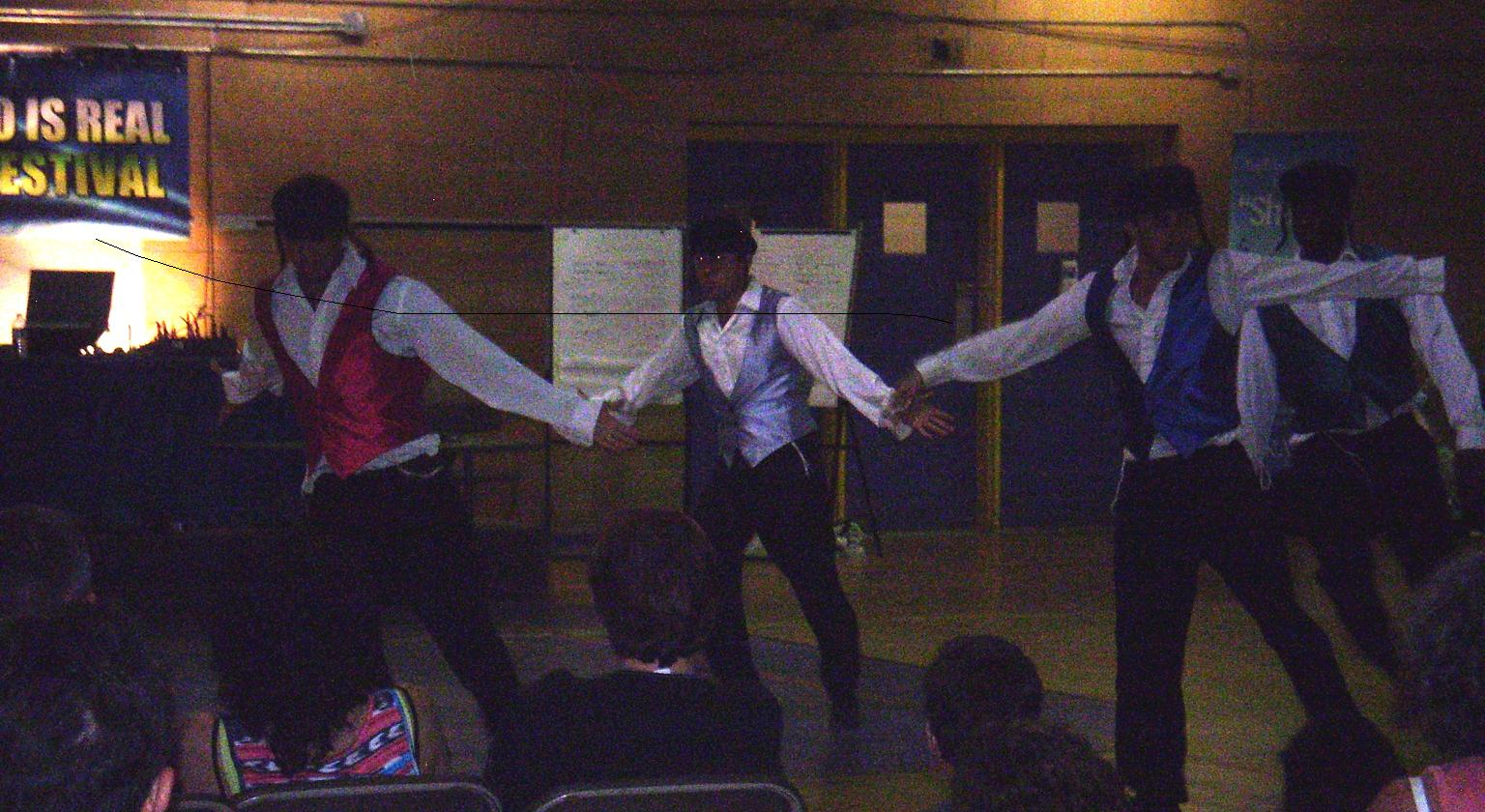
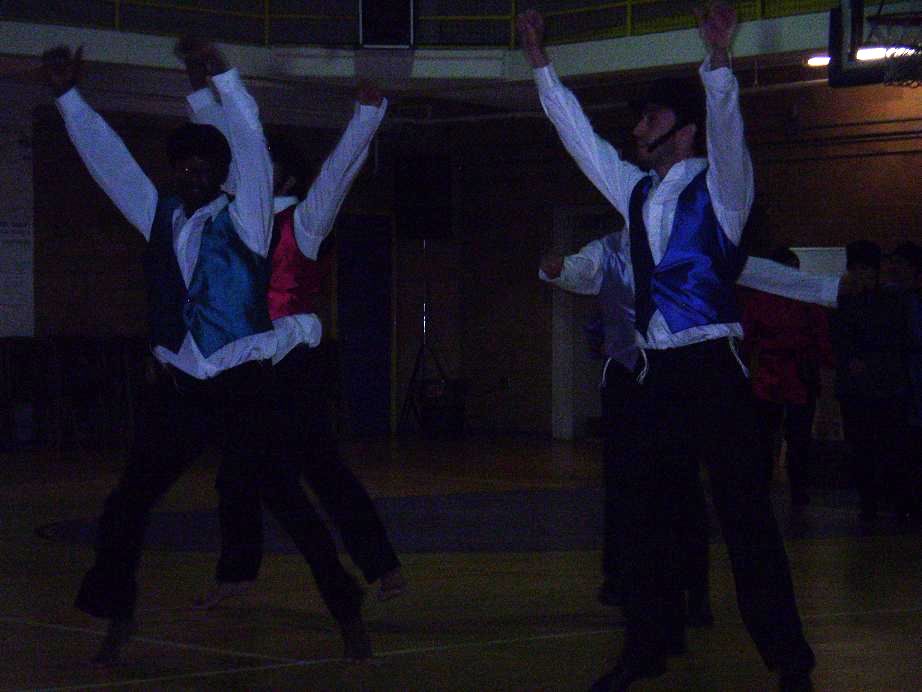
Mini Carmiel
Our dancers met up in the gym at the Miles Nadal center at 9:30 that evening. Some came from dining at local restaurants in the area and others partook of a dinner that was seved in the gym. Shortly, everyone in attendance was asked to vacate the gym and convene at the center's theater (or centre's theatre to be more precise as Canada utilizes British Spelling derivatives).
The Toronto Is Real Israeli dance festival occurs in the middle of the summer, in Early July. It is not the only such festival at this time of the year. In Israel, shortly thereafter, is the Carmiel festival (or Karmiel, in a variation of spelling). This is very prestigious in that country and it has several components including a competition between Choreographers.
We believe this is how it works in Carmiel (although this website is not the expert given that we are having enough problems trying to cover what is happening locally throughout the Phila area and have no reason to expand the horizon) in that a set of musical compositions - each piece of music having no Israeli dances associated with it - are selected and at random assigned to Choreographers who create steps for a dance to that piece of music. These dances are judged and for the winner it is a prestigious award. For the first time at Toronto, and for the first time outside of Israel the group was told, the organizers of Carmiel extended this using Toronto to also partake in the judging.
The dance group, Keshet Chaim, an American-Israeli dance group whose web site is www.kcdancers.org, performed the 12 dances with choreography from many famous Israeli dance choreographers and after this demonstration festival goers were invited to vote for their favorite. The Phila group was sitting together and, as we are told, most seemed to favor the 4th dance, a circle, or the nineth, a partner. As the group was to find out, it was the 11th dance, a partner choreographed by Shlomo Maman, that ruled that evening. This was announced on Sunday night as everyone in attendance was taught the dance.
A word should be made of the dance group, Kechet Chaim, who are in the pictures above. Beyond demonstrating the dances of the choreographers that Friday evening, they gave a performance in modern dance on Sunday evening (when the above pictures were taken) before the announcement of the Mini Carmiel winner.
Below, we present the list of dances and the choreographers that were used in the Mini Carmiel contest.
After the performance and the voting, it was back to the gym which had been cleared of the tables for dinner and now was ready for dancing. And dance away they did. We are told that dancing went to 3AM, normal for an Israeli dance workshop. Many left early, but there were a significant number of dancers remaining. At 3AM, it was off to bed to ready for the next day.
About the Choreographers
An integral part of any dance festival is the choreographers in attendance. Most attendees have an interest in a specific choreographer (or choreographers) based on the repertoire of dances created. For one of the group, this may not be all that was attractive. Andrea would be the first to admit that she has a "thing" for one of the choreographers at this festival, Dudu Barzilay, and she made sure that she could spend some quality time with him as indicated in the pictures to the right. Besides Andrea's specific interest, Dudu was a very good pick for the festival as he may have choreographed the dance of the year, Ma Kore Itach. The Philadelphia region was introduced to this dance on Memorial day when Don Schillinger taught this at the Memorial day workshops he organized.
This dance has become part of the repertoire in Don's sessions in this area. Recently, one dancer was overheard marvelling about this dance, "What is it", she mused, " that makes me like this dance", she asked another dancer. We assume that if this web site could answer this question, it would be the leading site on the internet. Best we can answer of this question is that this occurs infrequently. A choreographer picks an outstanding piece of music and then creates steps that highlight the beat of music even more. Dudu has done this with this dance, Ma Kore Itach, and not surprising, this dance was the first taught when the official teaching workshop began in earnest at 11Am in the morning on Saturday. July 2nd.
Dudu was joned by two other choreographers during this weekend: Victor Gabay and Ohad Atia (also spelled as Atiya). Victor Gabay is a legend for his long work in Israeli dance Choreography. The Israeli dances database has 101 of his choreographies listed and he is well known for his partner dances. However, one of the Philadelphia party, Sharon Polsky, was interested in a circle dance he showed at the festival that he had recently choreographered, Hora Adama, and this became the dance that she showed to her class, Tuesdays 7:30 to 9:45, first thing when back at home.
In addition, for those who spend a lot of time researching Israeli dances on youtube and the web, and this includes the person who updates our video section, the name, Ohad Atia, should be very familiar. Not as large of a choreographed repertoire as DuDu or Victor, Ohad has produced a set of teaching videos (unfortunately only in Hebrew) explaining many dances for those in need of instruction. For this weekend, he combined the teaching of his own choreographed dances with others.
Below is the dances taught at the festival. This is more extensive than what some documentation is indicating as the official teaching list. We are told that some of the dances below were taught extemperaneously and the dancer keeping track of the dances for this website added those dances to his list.
We must make mention of one other party to the teaching. All the choreographers listed above are male, yet there were plenty of partner dances taught and demonstrated. Someone, other than our choreographers, had to show the female (or follower) part. This fell to Meliss Jakubovic Bachar who is the leader of an Israeli dance session in Atlanta, Among her other duties in Atlanta is involvement with Nitzanim, a local (for that area) Israeli folk dance performing group.
Below are pictures of the 4 dance choreographers/leaders of the Toronto Is real Israeli dance workshop in the order of mention.
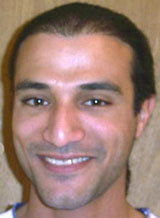
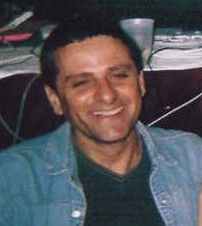
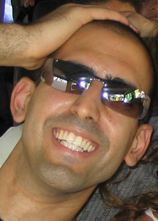
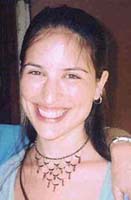
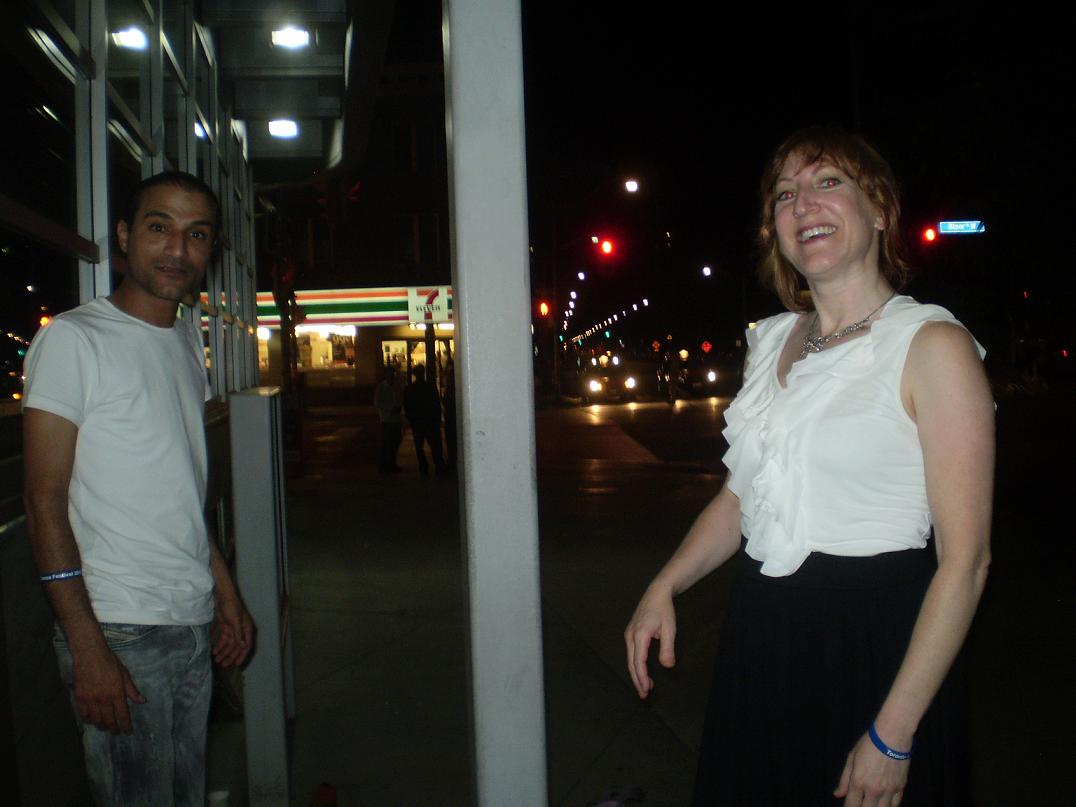
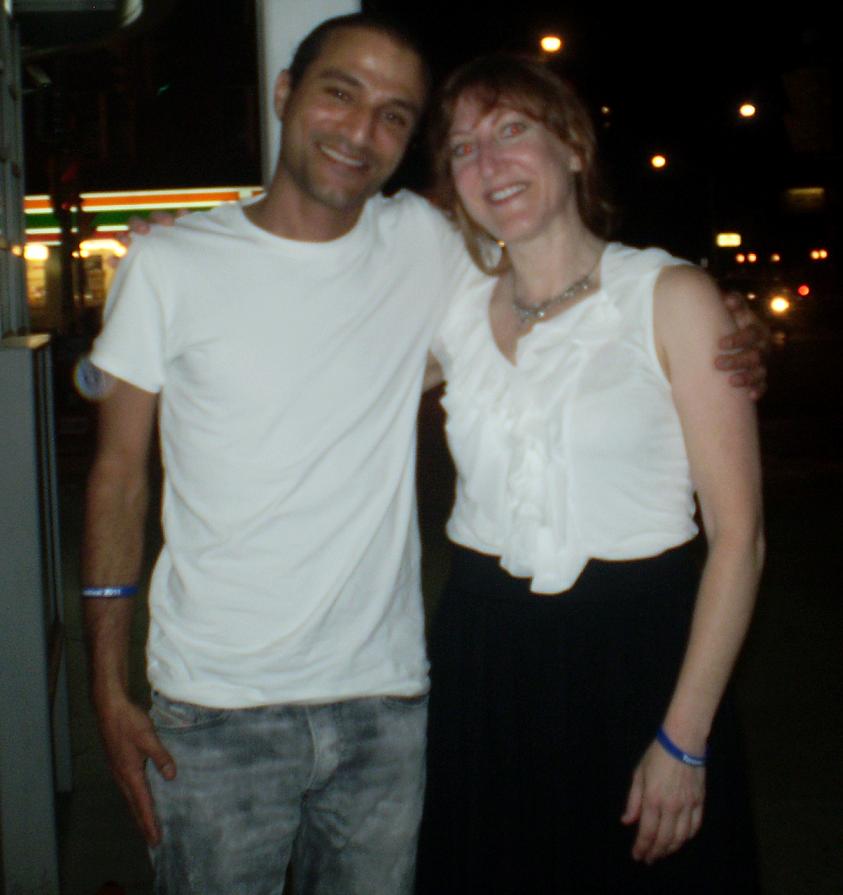
Discussion Of The Festival
So, how was the festival for our local Philadelphia based group of five? Most seemed to like it. One unanimous aspect was that of food. Continually restocked, the food at the festival, served in an anteroom of the Gym, was quite good and always available as related to this web site. But, Israeli dancers do not attend dance camps because of food. They attend because of music and dance although one of our dancers focused on her interaction with Dudu when asked how the festival had been. For her, other things really didn't matter. She was able to secure several shots with Dudu as you have seen above and even had a partner set with her favorite choreographer. This web site would qualify this weekend as a success for this dancer.
For the others, it was a question of dancing. Let's discuss the schedule as was indicated to this web site. Dancing started about 10:30PM if not later on Friday and went through the night. On Saturday and Sunday, instruction was given 11 to 4PM each day although we are told things petered out by 3:30. Something was scheduled each day of the weekend from 8:30 to 9:30 and at 9:30 each night, through the night dancing was in effect.
For many women, the question of enjoying sessions revolves around whether sufficient male partners will be available for the partner sets. This web site has noticed that this is a significant question that women face. The demographics, even if both sexes equally enjoyed dancing, tilts against women from a longevity standpoint. Adding in the factor that many men do not like any form of dancing and you could be running a 2 to 1 to 3 to 1 women to men ratio.
While the following solution did not resolve all complaints, the male of this group did make himself available as a partner on a round robin basis for his compatriots. Therefore, no woman would be shut out for the evening and apparently this resolved an important issue. So, for the three remaining women, they, for the most part, enjoyed the festival. All of them had been to the Toronto festival before and most expected to repeat the attendance in the future, probably next year.
So, that leaves our last attendee. From a partner basis, he was already guaranteed partners for as many of the partner sets he wished to dance and all his partners would be accepting of his limitations in doing this. However, he did complain that many of the circle dances, and the music associated with them, were unknown to him. Since he doesn't like to follow dances as he relies on his memory of steps, this was disappointing. Of course there were several other disappointments as mentioned above. Hassles pertaining to immigration, noise in his room, inability to use an ATM machine probably were the reason for his declaration that this was the worse vacation he had ever had. Well, every group has a spoil sport who can't relate and our group of five apparently was no exception. This web site tallies four as having a good time, one who did not. That's not a bad ratio.
Now, a little discussion about the dances taught through the weekend. There seems to have been a few that passed muster. One dance already was being taught in this area as mentioned above, Ma Korah Itach. Another dance, Hora Adama, would be taught by Sharon Polsky when she returned to her class in the following weeks. Since, for the most part, Sharon likes Victor Gabay's dances, this seems a reasonable selection for her to show to her students. A third dance, Lo Matzatim, would be taught in the next few weeks by Don. Interestingly, no partner dance has so far made it into the Philadelphia dance sessions either as a teach or a play.
You can get more information from the web site associated with the Toronto festival and Israeli dancing in that region. For specific info per the festival, click here and for Israeli dancing year round in the Toronto region itself, click here.
Our group did take a lot of pictures that they have shared with this web site and below, as we close out our coverage of the Toronto Is Real Israeli Dance Festival, we show a montage of the dancing throughout the weekend.
